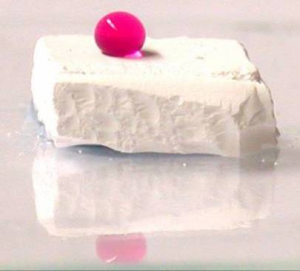Sensing Changes
Superhydrophobicity comes from the amplification of surface chemistry effects by the small-scale roughness of the surface. One example of this is a that a hydrophobic surface can become superhydrophobic when it is made into a foam. However, if it is possible to switch off the water-fearing surface chemistry, the foam will become a super-sponge and absorb water rather than repel it.

In these experiments the hydrophobic surface chemistry is switched off by heating the foam above a designed-in trigger temperature. The first image shows a droplet of water (with a pink food dye) on a superhydrophobic foam. The second image is the same foam once it has been heated above the designed trigger temperature. The foam itself looked no different the droplet of water was slurped up. This material could be used as a simple indicator of environmental history. For example, (in principle) it could be used to provide an alert that a food sample has exceeded a defined temperature at some point during its past.
The switching of superhydrophobicity can be designed to be triggered by many physical effects and not just heat exposure.
Further Information
Read more about these experiments in the publication list below. This effect is described by Nature as a super-sponge with a super-slurp.
Publications
- Porous materials show superhydrophobic to superhydrophilic switching N.J. Shirtcliffe, G. McHale, M.I. Newton, C.C. Perry and P. Roach, Chem. Comm. 25 (2005) 3135-3137
(see also Nature Highlight/News “Quick change for super sponge“, published online 20-July-2005, front cover image.) - Super-hydrophobic and super-wetting surfaces: Analytical potential? G. McHale, M.I. Newton and N.J. Shirtcliffe, Analyst 129 (2004) 284-287
- Superhydrophobic to superhydrophilic transitions of sol-gel films for temperature, alcohol or surfactant measurement N.J. Shirtcliffe, G. McHale, M.I. Newton C.C. Perry and P. Roach, Maters. Chem. & Phys. 103 (2007) 112-117

